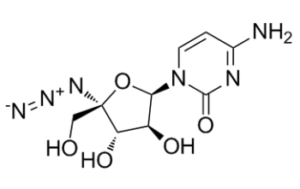This product is for research use only, not for human use. We do not sell to patients.

| Size | Price | Stock |
|---|---|---|
| 100mg | $750 | Check With Us |
| 250mg | $1250 | Check With Us |
| 500mg | $1875 | Check With Us |
Cat #: V3659 CAS #: 876708-03-1 Purity ≥ 98%
Description: RO-9187 is a novel and potent inhibitor of HCV virus replication with IC50 of 171 nM. RO-0622 and RO-9187 were excellent substrates for deoxycytidine kinase and were phosphorylated with efficiencies up to 3-fold higher than deoxycytidine. As compared with previous reports on ribonucleosides, higher levels of triphosphate were formed from RO-9187 in primary human hepatocytes, and both compounds were potent inhibitors of HCV virus replication in the replicon system (IC(50) = 171 +/- 12 nM and 24 +/- 3 nM for RO-9187 and RO-0622, respectively; CC(50) >1 mM for both). Both compounds inhibited RNA synthesis by HCV polymerases from either HCV genotypes 1a and 1b or containing S96T or S282T point mutations with similar potencies, suggesting no cross-resistance with either R1479 (4'-azidocytidine) or 2'-C-methyl nucleosides. Pharmacokinetic studies with RO-9187 in rats and dogs showed that plasma concentrations exceeding HCV replicon IC(50) values 8-150-fold could be achieved by low dose (10 mg/kg) oral administration. Therefore, 2'-alpha-deoxy-4'-azido nucleosides are a new class of antiviral nucleosides with promising preclinical properties as potential medicines for the treatment of HCV infection.
Publications Citing InvivoChem Products
Product Promise

- Physicochemical and Storage Information
- Protocol
- Related Biological Data
- Stock Solution Preparation
- Quality Control Documentation
| Molecular Weight (MW) | 284.232 |
|---|---|
| Molecular Formula | C9H12N6O5 |
| CAS No. | 876708-03-1 |
| Storage | -20℃ for 3 years in powder formr |
| -80℃ for 2 years in solvent | |
| SMILES Code | O=C1N=C(N)C=CN1[C@@H]2O[C@@](CO)(N=[N+]=[N-])[C@@H](O)[C@@H]2O |
| Synonyms | RO-9187; RO 9187; RO9187 |
| Protocol | In Vitro | RO-9187 is excellent substrates for deoxycytidine kinase and is phosphorylated with efficiencies up to 3-fold higher than deoxycytidine. RO-9187 inhibits RNA synthesis by HCV polymerases from either HCV genotypes 1a and 1b or containing S96T or S282T point mutations with similar potencies, suggesting no cross-resistance with either R1479 (4′-azidocytidine) or 2′-C-methyl nucleosides. The formation of RO-9187-TP increased in a time- and dose-dependent manner. The maximal triphosphate concentration at 24 h is 87 pmol/106 cells with half-maximal triphosphate formation achieved at 12 μM RO-9187. |
|---|---|---|
| In Vivo | Plasma exposures of RO-9187 in rats increase in a dose-dependent manner between 10 and 2000 mg/kg after oral dosing. Plasma concentrations of 1.4 and 26 μM (390 and 7454 ng/mL) are achieved in rats and dogs at the 10 mg/kg dose level, respectively. Plasma concentrations up to 57 μM are achieved in rats dosed with 2000 mg/kg/day. |
| Solvent volume to be added | Mass (the weight of a compound) | |||
|---|---|---|---|---|
| Mother liquor concentration | 1mg | 5mg | 10mg | 20mg |
| 1mM | 3.5183 mL | 17.5913 mL | 35.1825 mL | 70.3651 mL |
| 5mM | 0.7037 mL | 3.5183 mL | 7.0365 mL | 14.0730 mL |
| 10mM | 0.3518 mL | 1.7591 mL | 3.5183 mL | 7.0365 mL |
| 20mM | 0.1759 mL | 0.8796 mL | 1.7591 mL | 3.5183 mL |
This equation is commonly abbreviated as: C1 V1 = C2 V2
- (1) Please be sure that the solution is clear before the addition of next solvent. Dissolution methods like vortex, ultrasound or warming and heat may be used to aid dissolving.
- (2) Be sure to add the solvent(s) in order.




































